Fertigation and Carboxymethyl Cellulose Applications Enhance Water-Use Efficiency, Improving Soil Available Nutrients and Maize Yield in Salt-Affected Soil
Abstract
1. Introduction
2. Materials and Methods
2.1. Description of the Study Site
2.2. Experimental Design
2.3. Field Management of the Experiment
2.4. Sample Collection and Analysis
2.4.1. Soil Sample Collection and Analysis
2.4.2. Plant Sample Collection and Analysis
2.5. Statistical Analyses
3. Results
3.1. Soil Water Transport
3.2. Soil Salt Transport
3.3. Soil Desalination
3.4. Soil Available Nutrients
3.5. Water Utilization of Crops
3.6. Crop Growth
4. Discussion
4.1. Soil Water and Salt Transport
4.2. Soil Nutrients
4.3. Crop Responses
5. Conclusions
Author Contributions
Funding
Institutional Review Board Statement
Informed Consent Statement
Data Availability Statement
Acknowledgments
Conflicts of Interest
References
- Pitman, M.G.; Läuchli, A. Global impact of salinity and agricultural ecosystems. In Salinity: Environment-Plants-Molecules; Springer: Berlin/Heidelberg, Germany, 2002; pp. 3–20. [Google Scholar]
- Zhou, Q.; Zhu, Z.; Shi, M.; Cheng, L. Growth and physicochemical changes of Carpinus betulus L. influenced by salinity treatments. Forests 2018, 9, 354. [Google Scholar] [CrossRef]
- Mustafa, G.; Akhtar, M.S.; Abdullah, R. Global concern for salinity on various agro-ecosystems. In Salt Stress, Microbes, and Plant Interactions: Causes and Solution; Springer: Berlin/Heidelberg, Germany, 2019; pp. 1–19. [Google Scholar]
- Kumar, P.; Sharma, P.K. Soil salinity and food security in India. Front. Sustain. Food Syst. 2020, 4, 533781. [Google Scholar] [CrossRef]
- Luo, S.; Tian, L.; Chang, C.; Wang, S.; Zhang, J.; Zhou, X.; Li, X.; Tran, L.S.P.; Tian, C. Grass and maize vegetation systems restore saline-sodic soils in the Songnen Plain of northeast China. Land Degrad. Dev. 2018, 29, 1107–1119. [Google Scholar] [CrossRef]
- Xiong, S.; Xiong, Z.; Wang, P. Soil salinity in the irrigated area of the Yellow River in Ningxia, China. Arid Land Res. Manag. 1996, 10, 95–101. [Google Scholar]
- Munns, R.; Gilliham, M. Salinity tolerance of crops—What is the cost? New Phytol. 2015, 208, 668–673. [Google Scholar] [CrossRef] [PubMed]
- Stavi, I.; Thevs, N.; Priori, S. Soil salinity and sodicity in drylands: A review of causes, effects, monitoring, and restoration measures. Front. Environ. Sci. 2021, 9, 712831. [Google Scholar] [CrossRef]
- Guan, Z.; Jia, Z.; Zhao, Z.; You, Q. Dynamics and distribution of soil salinity under long-term mulched drip irrigation in an arid area of northwestern china. Water 2019, 11, 1225. [Google Scholar] [CrossRef]
- Pimentel, D.; Berger, B.; Filiberto, D.; Newton, M.; Wolfe, B.; Karabinakis, E.; Clark, S.; Poon, E.; Abbett, E.; Nandagopal, S. Water resources: Agricultural and environmental issues. BioScience 2004, 54, 909–918. [Google Scholar] [CrossRef]
- Rajak, D.; Manjunatha, M.; Rajkumar, G.; Hebbara, M.; Minhas, P. Comparative effects of drip and furrow irrigation on the yield and water productivity of cotton (Gossypium hirsutum L.) in a saline and waterlogged vertisol. Agric. Water Manag. 2006, 83, 30–36. [Google Scholar] [CrossRef]
- Burt, C.M.; Isbell, B. Leaching of accumulated soil salinity under drip irrigation. Trans. ASAE 2005, 48, 2115–2121. [Google Scholar] [CrossRef]
- Wang, Y.; Gao, M.; Chen, H.; Fu, X.; Wang, L.; Wang, R. Soil moisture and salinity dynamics of drip irrigation in saline-alkali soil of Yellow River basin. Front. Environ. Sci. 2023, 11, 345. [Google Scholar] [CrossRef]
- Wang, X.; Wang, J.; Wang, J. Seasonality of soil respiration under gypsum and straw amendments in an arid saline-alkali soil. J. Environ. Manag. 2021, 277, 111494. [Google Scholar] [CrossRef] [PubMed]
- D’Hose, T.; Debode, J.; De Tender, C.; Ruysschaert, G.; Vandecasteele, B. Has compost with biochar applied during the process added value over biochar or compost for increasing soil quality in an arable cropping system? Appl. Soil Ecol. 2020, 156, 103706. [Google Scholar] [CrossRef]
- Tang, C.; Yang, J.; Xie, W.; Yao, R.; Wang, X. Effect of Biochar Application on Soil Fertility, Nitrogen Use Efficiency and Balance in Coastal Salt-Affected Soil under Barley–Maize Rotation. Sustainability 2023, 15, 2893. [Google Scholar] [CrossRef]
- Rahman, M.S.; Hasan, M.S.; Nitai, A.S.; Nam, S.; Karmakar, A.K.; Ahsan, M.S.; Shiddiky, M.J.; Ahmed, M.B. Recent developments of carboxymethyl cellulose. Polymers 2021, 13, 1345. [Google Scholar] [CrossRef]
- Zhang, J.; Wang, Q.; Shan, Y.; Guo, Y.; Mu, W.; Wei, K.; Sun, Y. Effect of Sodium Carboxymethyl Cellulose on Water and Salt Transport Characteristics of Saline–Alkali Soil in Xinjiang, China. Polymers 2022, 14, 2884. [Google Scholar] [CrossRef]
- Olad, A.; Zebhi, H.; Salari, D.; Mirmohseni, A.; Tabar, A.R. Slow-release NPK fertilizer encapsulated by carboxymethyl cellulose-based nanocomposite with the function of water retention in soil. Mater. Sci. Eng. C 2018, 90, 333–340. [Google Scholar] [CrossRef]
- Qiu, Z.; Zhang, R.; Qiu, H.; Gao, J. Effects of superabsorbents containing montmorillonite and polysaccharide on soil physical properties. Soil Fertil. Sci. China 2013, 3, 11–16. [Google Scholar]
- Li, W.; Huang, S.; Xu, D.; Zhao, Y.; Zhang, Y.; Zhang, L. Molecular dynamics simulations of the characteristics of sodium carboxymethyl cellulose with different degrees of substitution in a salt solution. Cellulose 2017, 24, 3619–3633. [Google Scholar] [CrossRef]
- Zhao, Q.; Tang, J.; Li, Z.; Yang, W.; Duan, Y. The influence of soil physico-chemical properties and enzyme activities on soil quality of saline-alkali agroecosystems in Western Jilin Province, China. Sustainability 2018, 10, 1529. [Google Scholar] [CrossRef]
- Zhou, M.; Liu, X.; Meng, Q.; Zeng, X.; Zhang, J.; Li, D.; Wang, J.; Du, W.; Ma, X. Additional application of aluminum sulfate with different fertilizers ameliorates saline-sodic soil of Songnen Plain in Northeast China. J. Soils Sediments 2019, 19, 3521–3533. [Google Scholar] [CrossRef]
- Robbins, C.W.; Wiegand, C.L. Field and laboratory measurements. In Agricultural Salinity Assessment and Management; Tanji, K.K., Ed.; ASCE: New York, NY, USA, 1990; pp. 201–219. [Google Scholar]
- Pansu, M.; Gautheyrou, J. Handbook of Soil Analysis; Springer Science & Business Media: Berlin/Heidelberg, Germany, 2006. [Google Scholar]
- Zhang, T.; Zhan, X.; He, J.; Feng, H. Moving salts in an impermeable saline-sodic soil with drip irrigation to permit wolfberry production. Agric. Water Manag. 2019, 213, 636–645. [Google Scholar] [CrossRef]
- Qi, Z.; Feng, H.; Zhao, Y.; Zhang, T.; Yang, A.; Zhang, Z. Spatial distribution and simulation of soil moisture and salinity under mulched drip irrigation combined with tillage in an arid saline irrigation district, northwest China. Agric. Water Manag. 2018, 201, 219–231. [Google Scholar] [CrossRef]
- Sun, G.; Zhu, Y.; Gao, Z.; Yang, J.; Qu, Z.; Mao, W. Spatiotemporal Patterns and Key Driving Factors of Soil Salinity in Dry and Wet Years in an Arid Agricultural Area with Shallow Groundwater Table. Agriculture 2022, 12, 1243. [Google Scholar] [CrossRef]
- Motojima, H.; Yamada, P.; Irie, M.; Ozaki, M.; Shigemori, H.; Isoda, H. Amelioration effect of humic acid extracted from solubilized excess sludge on saline-alkali soil. J. Mater. Cycles Waste Manag. 2012, 14, 169–180. [Google Scholar] [CrossRef]
- Mosa, A.; Mansour, M.M.; Soliman, E.; El-Ghamry, A.; El Alfy, M.; El Kenawy, A.M. Biochar as a Soil Amendment for Restraining Greenhouse Gases Emission and Improving Soil Carbon Sink: Current Situation and Ways Forward. Sustainability 2023, 15, 1206. [Google Scholar] [CrossRef]
- Mosa, A.; Taha, A.A.; Elsaeid, M. In-situ and ex-situ remediation of potentially toxic elements by humic acid extracted from different feedstocks: Experimental observations on a contaminated soil subjected to long-term irrigation with sewage effluents. Environ. Technol. Innov. 2021, 23, 101599. [Google Scholar] [CrossRef]
- Kim, B.; Kim, T.-H.; Lee, B. Optimal synthesis of carboxymethylcellulose-based composite superabsorbents. Korean J. Chem. Eng. 2021, 38, 215–225. [Google Scholar] [CrossRef]
- Nie, H.; Liu, M.; Zhan, F.; Guo, M. Factors on the preparation of carboxymethylcellulose hydrogel and its degradation behavior in soil. Carbohydr. Polym. 2004, 58, 185–189. [Google Scholar] [CrossRef]
- Davidson, D.W.; Verma, M.S.; Gu, F.X. Controlled root targeted delivery of fertilizer using an ionically crosslinked carboxymethyl cellulose hydrogel matrix. SpringerPlus 2013, 2, 1–9. [Google Scholar] [CrossRef]
- Halidaimu, J.; Ning, S.; Wang, Q.; Zhang, J. Comparative analysis of the effects of PAM and CMC on soil infiltration and evaporation. Soil Water Conserv. 2020, 34, 121–127. [Google Scholar]
- Singh, B.; Singh, B.P.; Cowie, A.L. Characterisation and evaluation of biochars for their application as a soil amendment. Soil Res. 2010, 48, 516–525. [Google Scholar] [CrossRef]
- Lwin, C.S.; Seo, B.-H.; Kim, H.-U.; Owens, G.; Kim, K.-R. Application of soil amendments to contaminated soils for heavy metal immobilization and improved soil quality—A critical review. Soil Sci. Plant Nutr. 2018, 64, 156–167. [Google Scholar] [CrossRef]
- Wu, H.; Lai, C.; Zeng, G.; Liang, J.; Chen, J.; Xu, J.; Dai, J.; Li, X.; Liu, J.; Chen, M. The interactions of composting and biochar and their implications for soil amendment and pollution remediation: A review. Crit. Rev. Biotechnol. 2017, 37, 754–764. [Google Scholar] [CrossRef] [PubMed]
- Li, H.; Wang, Q.; Tao, W.; Chai, J.; Zhao, G. Effects of different amendments on the yield of surface runoff and loss of nutrients along loess slope soybean farmland. Sci. Soil Water Conserv. 2017, 15, 117–125. [Google Scholar]
- Senna, A.M.; Botaro, V.R. Biodegradable hydrogel derived from cellulose acetate and EDTA as a reduction substrate of leaching NPK compound fertilizer and water retention in soil. J. Control. Release 2017, 260, 194–201. [Google Scholar] [CrossRef]
- Dungait, J.A.; Hopkins, D.W.; Gregory, A.S.; Whitmore, A.P. Soil organic matter turnover is governed by accessibility not recalcitrance. Glob. Chang. Biol. 2012, 18, 1781–1796. [Google Scholar] [CrossRef]
- Zhang, H.; Yang, H.; Shao, J.; Chen, Y.; Zhang, S.; Chen, H. Multifunctional carboxymethyl cellulose sodium encapsulated phosphorus-enriched biochar composites: Multistage adsorption of heavy metals and controllable release of soil fertilization. Chem. Eng. J. 2023, 453, 139809. [Google Scholar] [CrossRef]
- Wu, J.; Tao, W.; Wang, H.; Wang, Q. Influence of sodium carboxyl methyl cellulose on soil aggregate structureand soil water movement. Trans. Chin. Soc. Agric. Eng. 2015, 31, 117–123. [Google Scholar]
- Qu, W.; Tan, Y.; Li, Z.; Aarnoudse, E.; Tu, Q. Agricultural Water Use Efficiency—A Case Study of Inland-River Basins in Northwest China. Sustainability 2020, 12, 10192. [Google Scholar] [CrossRef]
- Nachshon, U. Cropland soil salinization and associated hydrology: Trends, processes and examples. Water 2018, 10, 1030. [Google Scholar]
- Li, Y.; Li, M.; Liu, H.; Qin, W. Influence of soil texture on the process of subsurface drainage in saturated-unsaturated zones. Int. J. Agric. Biol. Eng. 2021, 14, 82–89. [Google Scholar] [CrossRef]
- Rüegg, W.; Richner, W.; Stamp, P.; Feil, B. Accumulation of dry matter and nitrogen by minimum-tillage silage maize planted into winter cover crop residues. Eur. J. Agron. 1998, 8, 59–69. [Google Scholar] [CrossRef]
- Wang, D.; Mo, Y.; Li, G.; Wilkerson, C.J.; Hoogenboom, G. Improving maize production and decreasing nitrogen residue in soil using mulched drip fertigation. Agric. Water Manag. 2021, 251, 106871. [Google Scholar] [CrossRef]
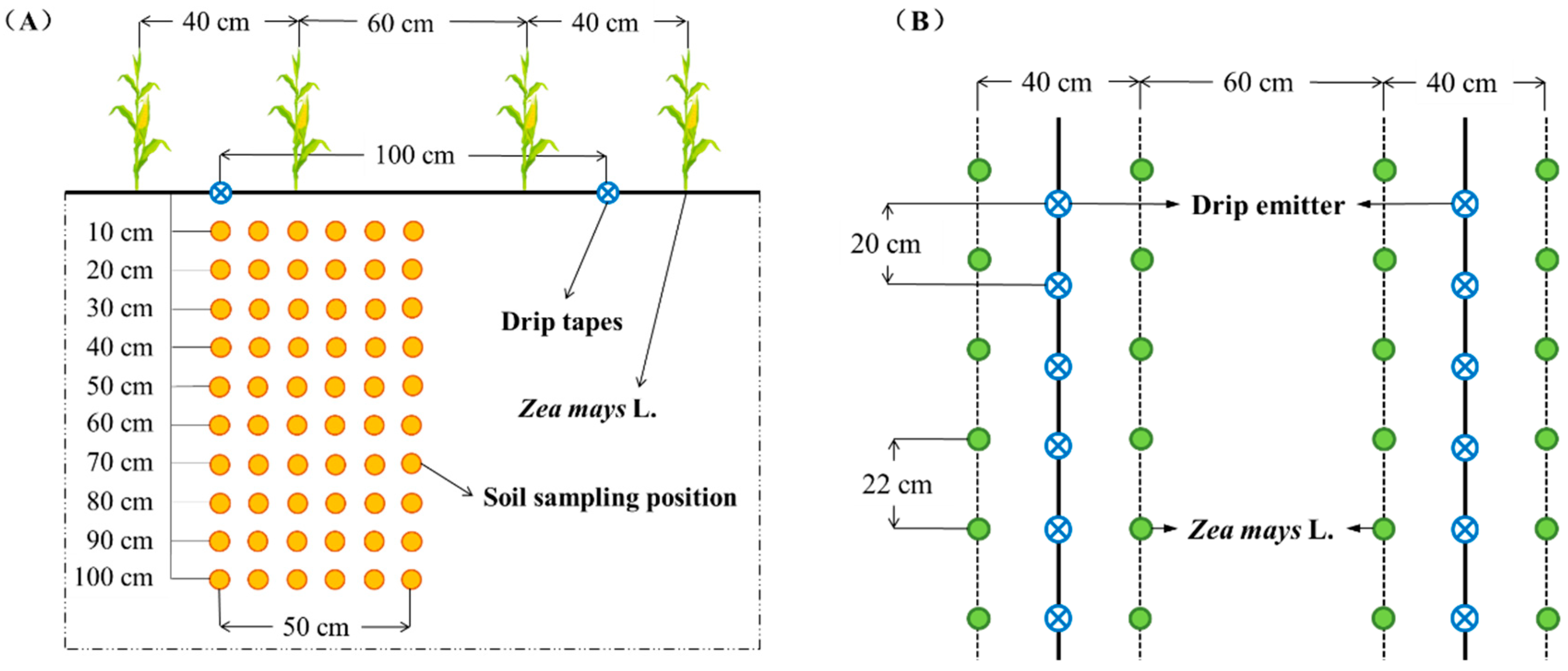
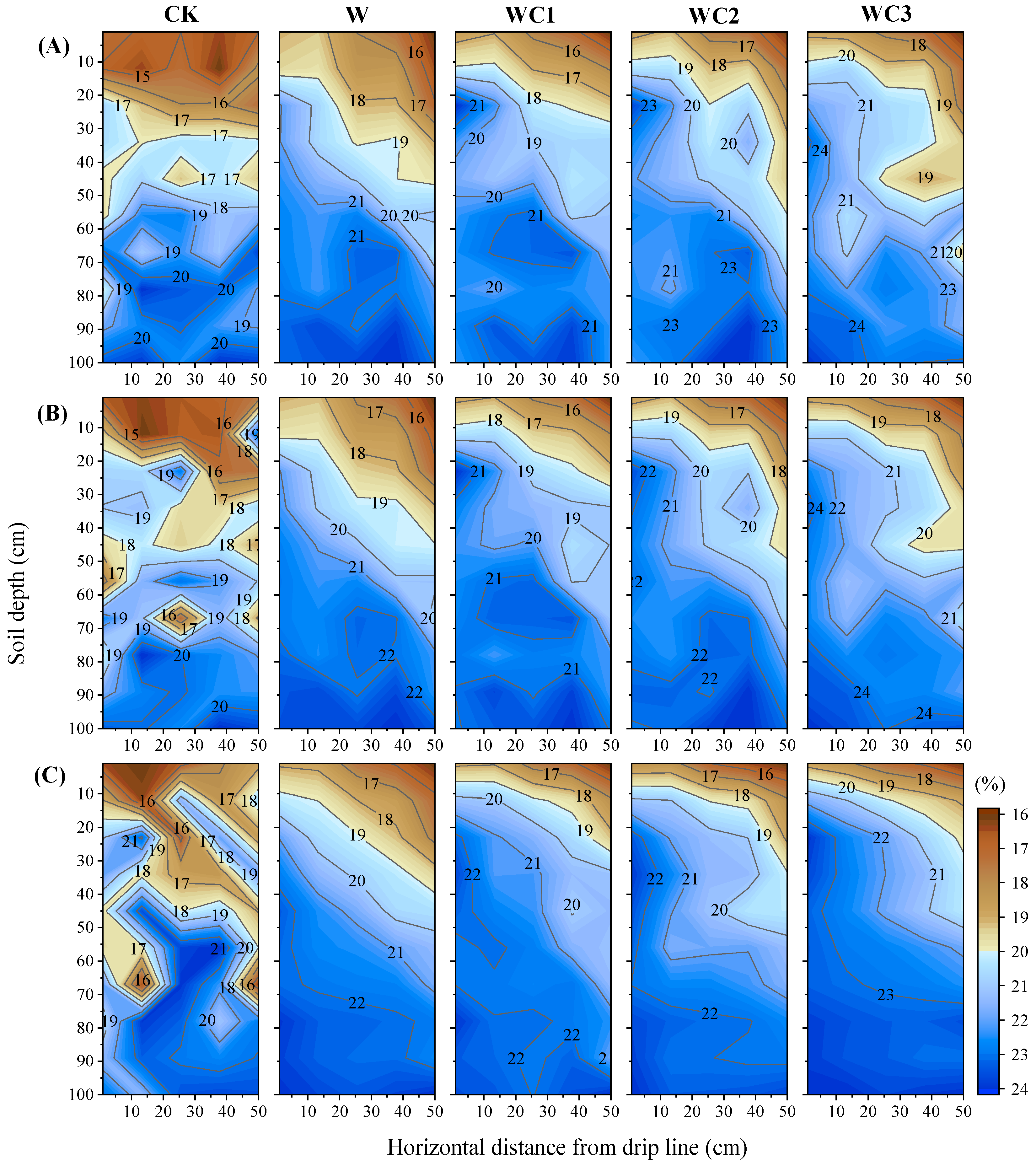
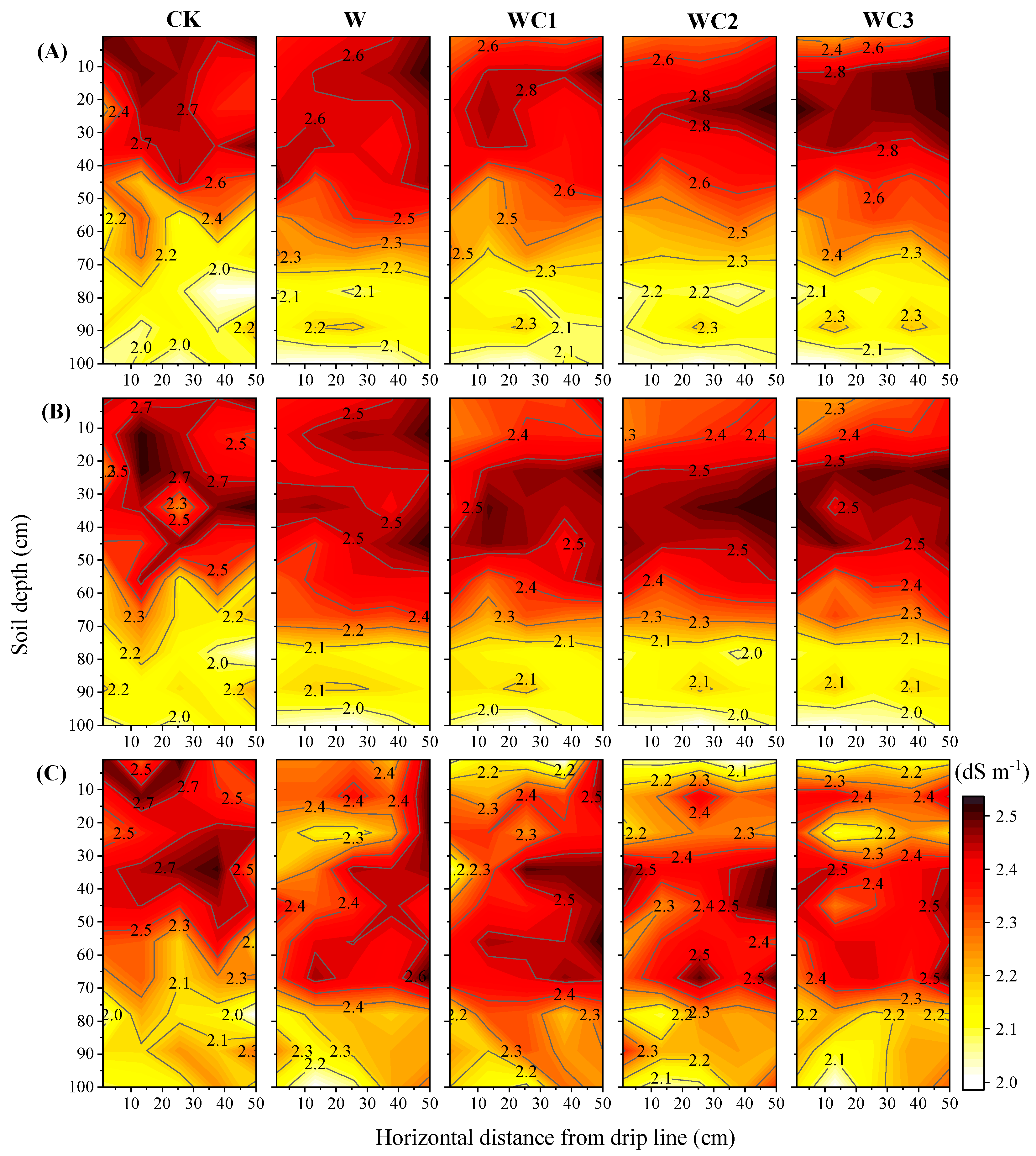
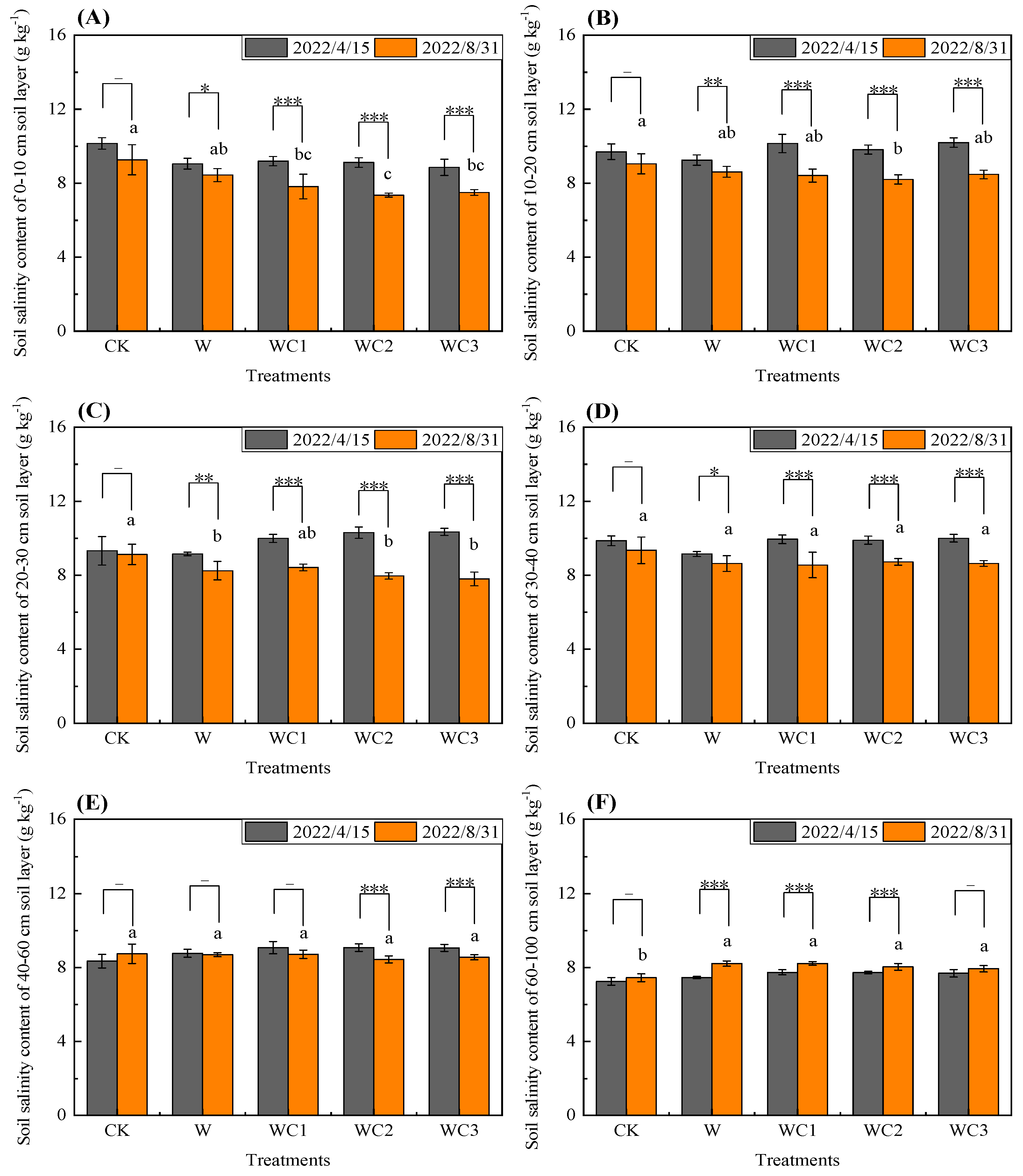
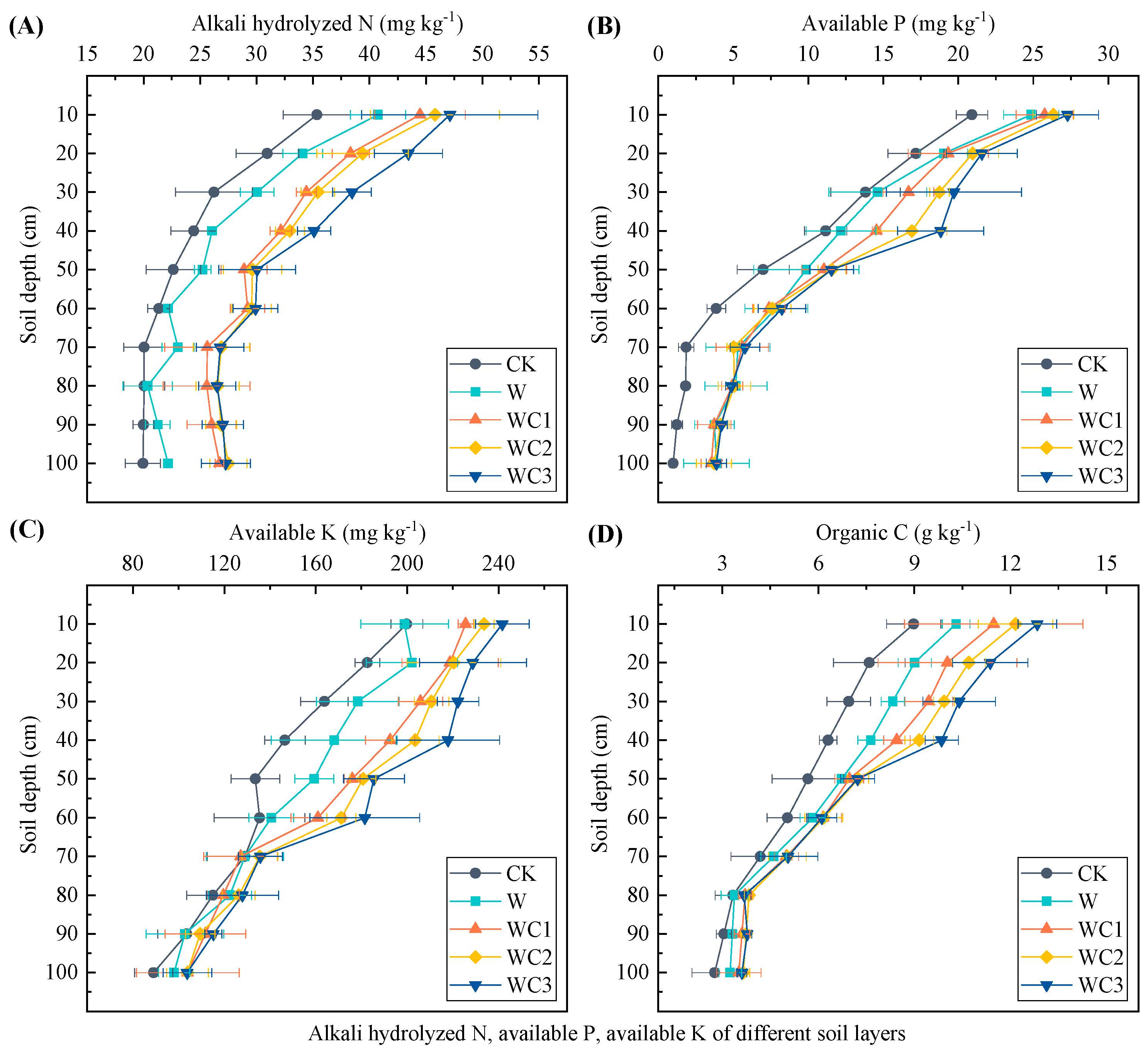
| Temperature and Rainfall Conditions in the Field Trial Area | |
|---|---|
| Annual average temperature | 8.7 °C |
| Effective accumulated temperature | 3100–3300 °C |
| Diurnal temperature range | 10–15 °C |
| Annual average sunshine duration | 2800–3000 h |
| Sunshine rate | 68% |
| Average annual precipitation | 190–210 mm |
| Average annual evaporation | 1900–2000 mm |
| Frost-free period | 165–170 d |
| Soil Layer | Bulk Density | Organic Matter | pH | EC 1 | ESP 2 |
|---|---|---|---|---|---|
| (cm) | (g cm−3) | (g kg−1) | (dS m−1) | (%) | |
| 0–10 | 1.36 | 15.79 | 8.72 | 2.80 | 23.46 |
| 10–20 | 1.46 | 14.31 | 8.77 | 2.59 | 22.29 |
| 20–30 | 1.46 | 12.51 | 8.68 | 2.32 | 21.16 |
| 30–40 | 1.55 | 12.02 | 8.65 | 2.65 | 22.65 |
| 40–50 | 1.54 | 10.15 | 8.60 | 2.53 | 21.68 |
| 50–60 | 1.53 | 9.36 | 8.38 | 2.41 | 20.91 |
| 60–70 | 1.55 | 7.19 | 8.58 | 2.33 | 20.52 |
| 70–80 | 1.56 | 5.78 | 8.23 | 2.22 | 19.90 |
| 80–90 | 1.55 | 5.21 | 8.54 | 2.22 | 19.91 |
| 90–100 | 1.55 | 5.18 | 8.14 | 2.10 | 19.24 |
| Treatment | Irrigation Amount (mm) | Fertilization Rates | CMC * | ||||||
|---|---|---|---|---|---|---|---|---|---|
| Seedling | Jointing | Flowering | Maturation | Total | (kg ha−1) | (kg ha−1) | |||
| CK | 260 | 250 | 190 | 200 | 900 | N | P2O5 | K2O | 0 |
| W | 135 | 135 | 90 | 90 | 450 | 400 | 200 | 225 | 0 |
| WC1 | 135 | 135 | 90 | 90 | 450 | 400 | 200 | 225 | 100 |
| WC2 | 135 | 135 | 90 | 90 | 450 | 400 | 200 | 225 | 200 |
| WC3 | 135 | 135 | 90 | 90 | 450 | 400 | 200 | 225 | 300 |
| Soil Layer | CK | W | WC1 | WC2 | WC3 |
|---|---|---|---|---|---|
| (cm) | (%) | (%) | (%) | (%) | (%) |
| 0–10 | 7.84 cAB | 16.00 bA | 22.23 abA | 26.72 aA | 25.32 aA |
| 10–20 | 2.55 aAB | 7.31 aABC | 9.43 aB | 11.59 aB | 8.83 aB |
| 20–30 | −9.11 bB | 1.55 abBCD | −0.47 abAB | 4.90 abBCD | 7.06 aB |
| 30–40 | 1.80 aAB | 9.35 aAB | 10.08 aB | 8.52 aBC | 9.36 aB |
| 40–50 | −3.81 aAB | 3.43 aBCD | 3.99 aAB | 4.31 aBCD | 4.60 aBC |
| 50–60 | 3.84 aAB | −2.67 aCD | −3.77 aB | 2.29 aBCD | −0.63 aBC |
| 60–70 | 2.55 aAB | −7.92 aD | −7.17 aB | −5.35 aD | −5.02 aBC |
| 70–80 | 10.00 aA | −3.64 aCD | −4.62 aB | −0.83 aCD | 0.44 aC |
| 80–90 | 1.51 aAB | −4.35 aCD | −4.22 aB | −3.00 aCD | 0.14 aBC |
| 90–100 | 1.85 aAB | −7.81 aD | −7.40 aB | −5.15 aD | −4.73 aC |
| Average SDR * | 1.90 | 1.12 | 1.81 | 4.40 | 4.54 |
| Treatment | I 1 | P 2 | ΔS 3 | L 4 | E 5 | (L + E)/(I + P) | ET 6 | WUE 7 |
|---|---|---|---|---|---|---|---|---|
| (mm) | (mm) | (mm) | (mm) | (mm) | (%) | (mm) | (kg ha−1 mm−1) | |
| CK | 900.0 | 166.7 | 35.41 c | 18.84 a | 418.3 a | 41.01 a | 664.9 a | 16.39 b |
| W | 450.0 | 166.7 | 52.98 b | 14.25 b | 180.7 b | 31.65 b | 474.7 b | 26.03 a |
| WC1 | 450.0 | 166.7 | 56.92 ab | 13.35 b | 134.7 c | 24.03 c | 525.6 b | 23.76 a |
| WC2 | 450.0 | 166.7 | 62.65 ab | 12.45 b | 135.0 c | 23.91 c | 531.9 b | 23.68 a |
| WC3 | 450.0 | 166.7 | 69.28 a | 11.52 b | 134.6 c | 23.70 c | 539.9 b | 23.42 a |
| Treatment | Plant Height | Stem Diameter | Aboveground Biomass | Grain Yield | Aboveground Biomass Increase | Grain Yield Increase |
|---|---|---|---|---|---|---|
| (cm) | (mm) | (kg·ha−1) | (kg·ha−1) | (%) | (%) | |
| CK | 297.7 | 20.22 | 47,284 b | 10,868 b | - | - |
| W | 298.4 | 20.38 | 49,157 ab | 12,356 ab | 4.00 | 13.98 |
| WC1 | 311.1 | 20.75 | 49,324 ab | 12,474 ab | 4.35 | 15.07 |
| WC2 | 302.3 | 20.58 | 49,564 a | 12,592 a | 4.85 | 16.16 |
| WC3 | 323.8 | 21.12 | 49,839 a | 12,633 a | 5.44 | 16.43 |
| Treatment | Soluble Sugar | Crude Protein | Crude Fat | Starch |
|---|---|---|---|---|
| (%) | (%) | (%) | (%) | |
| CK | 2.71 a | 8.41 c | 3.24 a | 63.96 a |
| W | 2.92 a | 8.49 bc | 3.32 a | 65.08 a |
| WC1 | 2.96 a | 8.66 abc | 3.35 a | 64.62 a |
| WC2 | 2.88 a | 8.76 ab | 3.23 a | 65.30 a |
| WC3 | 2.94 a | 8.82 a | 3.36 a | 65.33 a |
Disclaimer/Publisher’s Note: The statements, opinions and data contained in all publications are solely those of the individual author(s) and contributor(s) and not of MDPI and/or the editor(s). MDPI and/or the editor(s) disclaim responsibility for any injury to people or property resulting from any ideas, methods, instructions or products referred to in the content. |
© 2023 by the authors. Licensee MDPI, Basel, Switzerland. This article is an open access article distributed under the terms and conditions of the Creative Commons Attribution (CC BY) license (https://creativecommons.org/licenses/by/4.0/).
Share and Cite
Wang, Y.; Gao, M.; Chen, H.; Chen, Y.; Wang, L.; Wang, R. Fertigation and Carboxymethyl Cellulose Applications Enhance Water-Use Efficiency, Improving Soil Available Nutrients and Maize Yield in Salt-Affected Soil. Sustainability 2023, 15, 9602. https://doi.org/10.3390/su15129602
Wang Y, Gao M, Chen H, Chen Y, Wang L, Wang R. Fertigation and Carboxymethyl Cellulose Applications Enhance Water-Use Efficiency, Improving Soil Available Nutrients and Maize Yield in Salt-Affected Soil. Sustainability. 2023; 15(12):9602. https://doi.org/10.3390/su15129602
Chicago/Turabian StyleWang, Yaqi, Ming Gao, Heting Chen, Yiwen Chen, Lei Wang, and Rui Wang. 2023. "Fertigation and Carboxymethyl Cellulose Applications Enhance Water-Use Efficiency, Improving Soil Available Nutrients and Maize Yield in Salt-Affected Soil" Sustainability 15, no. 12: 9602. https://doi.org/10.3390/su15129602
APA StyleWang, Y., Gao, M., Chen, H., Chen, Y., Wang, L., & Wang, R. (2023). Fertigation and Carboxymethyl Cellulose Applications Enhance Water-Use Efficiency, Improving Soil Available Nutrients and Maize Yield in Salt-Affected Soil. Sustainability, 15(12), 9602. https://doi.org/10.3390/su15129602





